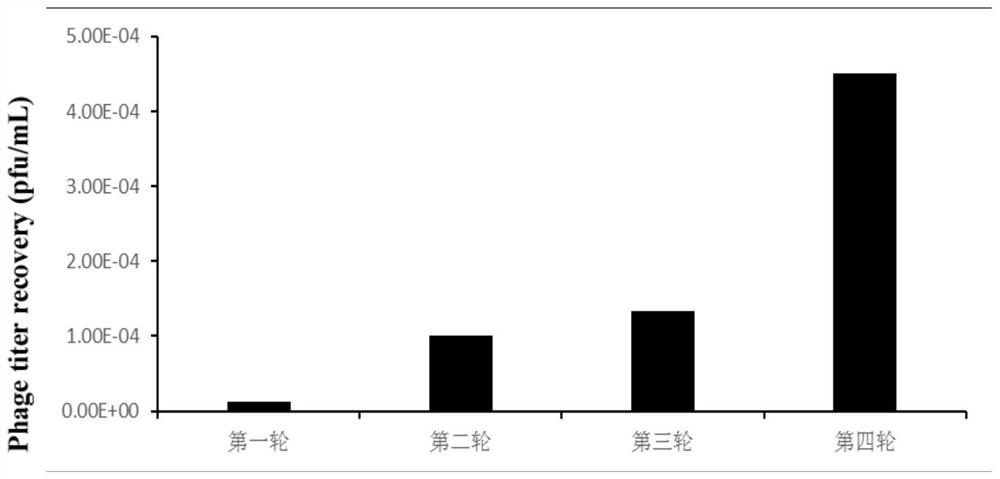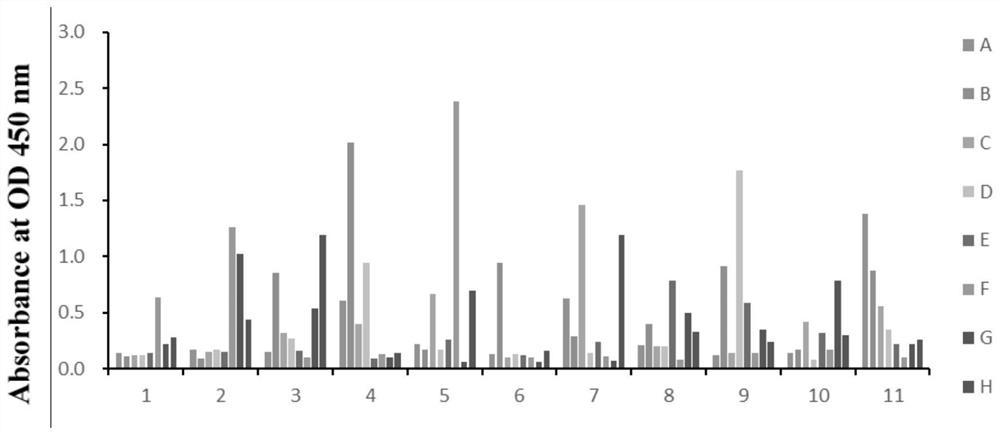A kind of PD-1 targeting blocking peptide and its application
A PD-1, targeting technology, applied in the biological field to achieve anti-tumor effect, significant effect, and the effect of restoring lymphocyte activity
- Summary
- Abstract
- Description
- Claims
- Application Information
AI Technical Summary
Problems solved by technology
Method used
Image
Examples
Embodiment 1
[0031] Preparation and activation of host bacteria:
[0032] The following operations need to be sterile in the ultra-clean workbench:
[0033] 1. Melt 100 mL of LB solid medium, add 100 μL of tetracycline stock solution when the temperature drops to 50-60 °C, and pour about 20 mL into a sterile petri dish (Φ=0.9 cm) after mixing to prepare a final concentration of 20 μg / mL Tetracycline resistance-LB plate (Tet-LB plate);
[0034] 2. Streak the strain E.coli ER2738 stored at -70°C on a Tet-LB plate, invert at 37°C overnight (about 16-18h), and store it in a 4°C refrigerator for two weeks;
[0035] 3. Prepare a sterile test tube containing 2 mL of LB liquid medium, add 2 μL of tetracycline stock solution with a concentration of 20 mg / mL, and the final concentration is 20 μg / mL;
[0036] 4. Pick the ER2738 monoclonal colony on the Tet-LB plate into 2 mL of Tet-LB medium, and shake and culture at 37°C overnight for use.
Embodiment 2
[0038] Amplification of phage libraries:
[0039] 1. Inoculate 200 μL of overnight cultured ER2738 in 200 mL of sterilized LB liquid medium, and incubate with vigorous shaking at 37°C for about 2 to 2.5 hours to reach the logarithmic growth phase (OD600 nm absorbance value is 0.4 to 0.6);
[0040] 2. Dilute 1.5 μL of the original phage library in 150 μL of TBS buffer solution; infect 200 mL of ER2738 bacterial broth in log phase with 100 μL of the diluted phage library;
[0041] 3. Mix well and let stand for 15 minutes, then vigorously shake at 220-250 rpm at 37°C for 4.5-5 hours;
[0042]4. Collect the culture in a sterilized centrifuge cup, pre-cool at 4°C, and centrifuge at 10,000 rpm for 10 min;
[0043] 5. Transfer the supernatant phage solution obtained after centrifugation to a new centrifuge cup, add 1 / 5 volume of PEG / NaCl (about 40 mL), mix well and place at 4°C overnight (about 16-18h) to allow the phage Precipitation is complete;
[0044] 6. Centrifuge the sample...
Embodiment 3
[0050] Phage titer determination:
[0051] 1. Preparation of the lower IPTG / X-gal / LB plate: Heat and melt 100 mL of solid LB medium and cool it to about 55°C, add 100 μL IPTG / X-gal stock solution evenly, mix quickly and pour the sterile plate (Φ = 0.9 cm). After cooling, cover with plastic wrap and pre-warm at 37°C for later use;
[0052] 2. Preparation of the upper layer of LB semi-solid agar: the semi-solid LB medium was heated and melted and cooled to 55°C, and each 3 mL of it was dispensed into sterile EP tubes, and the water bath was kept at 45°C for later use;
[0053] 3. Transfer the ER2738 cultured overnight in step 3 of 1.2.1 into LB liquid medium at 1:100 (a total of 2-3 mL of culture can be prepared), and shake vigorously at 37°C for about 2 hours to make it logarithmic growth period;
[0054] 4. Pack ER2738 in logarithmic growth phase into 1.5mL sterilized Eppendorf (EP) at 200μL / branch;
[0055] 5. Prepare serial dilutions of phage solution:
[0056] (1) Dist...
PUM
| Property | Measurement | Unit |
|---|---|---|
| encapsulation rate | aaaaa | aaaaa |
Abstract
Description
Claims
Application Information
 Login to View More
Login to View More - R&D
- Intellectual Property
- Life Sciences
- Materials
- Tech Scout
- Unparalleled Data Quality
- Higher Quality Content
- 60% Fewer Hallucinations
Browse by: Latest US Patents, China's latest patents, Technical Efficacy Thesaurus, Application Domain, Technology Topic, Popular Technical Reports.
© 2025 PatSnap. All rights reserved.Legal|Privacy policy|Modern Slavery Act Transparency Statement|Sitemap|About US| Contact US: help@patsnap.com



